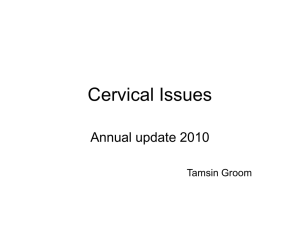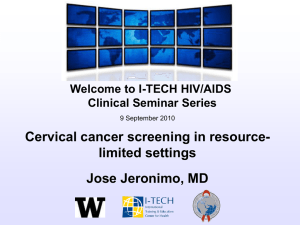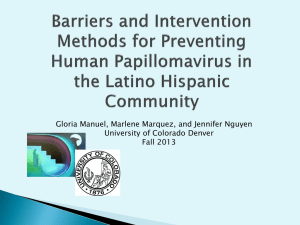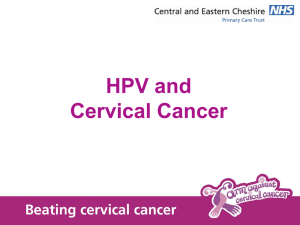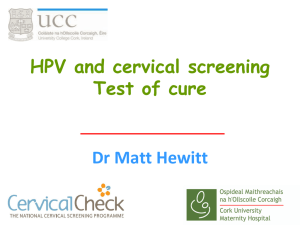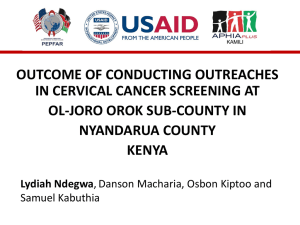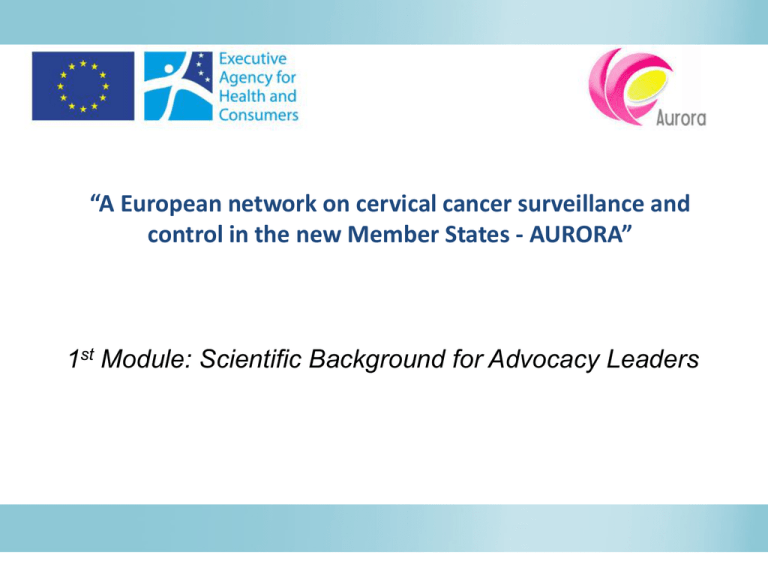
“A European network on cervical cancer surveillance and
control in the new Member States - AURORA”
1st Module: Scientific Background for Advocacy Leaders
www.aurora-project.eu
This publication arises from the project «AURORA» which has received funding from
the European Union in the Framework of the Health Programme.
Index
1. Cervical cancer epidemiology. Risk factors
2. Introductory issues about STIs and HPV infection –
transmission
3. Diagnosis of HPV infection.
4. How to organise a population based screening programme
5. Prevention of infection: vaccination
6. Diagnosis and treatment of cervical cancer disease
CERVICAL CANCER EPIDEMIOLOGY
1. Cervical cancer epidemiology
• Cervical cancer is the third most common cancer in women
with an estimated 530 000 new cases in 2008. More than 85%
of the global burden occurs in developing countries, where it
accounts for 13% of all female cancers.
High-risk regions are Eastern and Western Africa (ASR-age
standardised rate /incidence per 100000 women greater then
30 per 100,000), Southern Africa (26,8 per 100 000), SouthCentral Asia (24,6 per 100 000), South America and Middle
Africa (ASRs 23,9 and 23,0 per 100 000 respectively).
•
Rates are lower in Western Asia, Northern America and Australia/New Zealand (ASRs less than
6 per 100.000). Cervical cancer remains the most common cancer in women only in Eastern
Africa, South-Central Asia and Melanesia.
• Using crude incidence rates, cervical cancer ranks as the 2nd most frequent cancer among
women between 15 and 44 years of age.
•
http://globocan.iarc.fr/factsheet.asp: Ferlay J, Shin HR, Bray F, Forman D, Mathers C and Parkin DM. GLOBOCAN 2008 v1.2,
Cancer Incidence and Mortality Worldwide: IARC CancerBase No. 10 International Agency for Research on Cancer; 2010.
Bray F, Ren JS, Masuyer E, Ferlay J. Estimates of global cancer prevalence in 2008 for 27 sites in the adult population, submitted.
Mortality
Overall, the mortality incidence
ratio is 52%, and cervical cancer
is responsible for 275.000 deaths
in 2008, about 88% of which
occur in developing countries:
53.000 in Africa, 31.700 in Latin
America and the Caribbean, and
159.800 in Asia.
http://globocan.iarc.fr/factsheet.asp: Ferlay J, Shin HR, Bray F, Forman D, Mathers C and Parkin DM. GLOBOCAN 2008 v1.2, Cancer Incidence and
Mortality Worldwide: IARC CancerBase No. 10 International Agency for Research on Cancer; 2010.
Bray F, Ren JS, Masuyer E, Ferlay J. Estimates of global cancer prevalence in 2008 for 27 sites in the adult population, submitted.
Cervical cancer incidence
Worldwide
Estimated incidence from Cervix uteri cancer in 2008 ;
Age Standardised Rate (European) per 100,000
Europe
European Cancer Observatory
http://eu-cancer.iarc.fr/cancer-14-cervix-uteri.html,en
Cervical cancer mortality
Worldwide
Estimated mortality from Cervix uteri cancer in 2008 ;
Age Standardised Rate (European) per 100,000
Europe
European Cancer Observatory
http://eu-cancer.iarc.fr/cancer-14-cervix-uteri.html,en
HPV INFECTION
AND TRANSMISSION
HPV Transmission
● Through sexual intercourse
● Without sexual intercourse – through genital contact with an infected person
● In rare cases - from mother to baby during vaginal delivery
● HPV can be passed even when the infected partner has no signs or symptoms
Not all HPV infections will lead to cervical cancer. Most of the HPV infection will
clear spontaneously or after treatment. Cytologic screening will allow early
detection and effective intervention, but cervical cancer can not develop without a
persistent HPV infection!
(http://www.cdc.gov/std/hpv/commonclinicians/ClinicianBro.txt).
◄ Schiffman & Castle, 2005
HPV Related Cervical
Disease by Age
Risk Factors
HPV infection is the necessary cause of cervical cancer, but HPV
infection is not sufficient to cause cervical cancer. Most of women
infected with an oncogenic HPV type never develop cervical cancer,
therefore additional factors contribute to cervical cancer development.
Age of sexual debut, lifetime number of sexual partners, history of
sexually transmitted infections, and other characteristics of sexual
activity are linked to the likelihood of HPV infection, but are not
cofactors for the progression from HPV infection to cervical cancer.
Parity, use of oral contraceptives, tobacco smoking, immunosuppression
(particularly related to HIV), infection with other sexually transmitted
diseases, and poor nutrition, have been associated, to various extents,
with the development of invasive cervical cancer.
http://screening.iarc.fr/doc/RH_fs_risk_factors.pdf
◄ The key
events that
occur following
infection.
This patterns of
gene expression is
apparent in lowgrade squamous
intraepithelial
neoplasia (LSIL).
Doorbar J. Clinical
Science (2006)110,
525-541
HPV infection
Transient infection - asymptomatic,
Persistent infection - is not cleared
subclinical
• no clinical consequences in
immunocompetent individuals.
• incubation period – unclear, probably
weeks to months for genital warts,
several months to years for cervical
cellular abnormalities.
by the immune system - persistently
detectable HPV DNA.
factors:
• older age,
• high-risk HPV types,
• immunodeficiency.
Classification of Oncogenic Risk by HPV Genotype
There are over 100 different types of HPVs.
Over 30 types are involved in genital infections.
Based on their oncogenic power they are divided in “low risk” (LR) and “high risk”
High-risk (HR)
oncogenic
16, 18, 31, 33, 35, 39, 45, 51, 52, 56, 58,59, 66, 68, 69, 73,82
Low-risk (LR)
6, 11, 40, 42, 43, 44, 54, 61, 70, 72, 81, 89
• HR types cause cervical intraepithelial neoplasia (CIN) and invasive cancer. 99% of all cervical cancer cases are
caused by HPV infection.
• Two HR types, HPV16 and 18, cause over 70% of cervical cancers, with type 16 having the greatest oncogenic
potential.
• The LR types such as HPV6 and HPV11 are associated with condyloma acuminate and LSIL (Low-grade cervical
lesions)
• The distribution of HPV types varies among geographical regions, but the dominant oncogenic type in all
regions is HPV-16
Natural History of HPV infection
Normal
Infection
Clearance >90%
HPV
infection
Progression 10%
Regression 70%
Precancer (LSIL)
Progression 30%
Regression 30 %
Transient infection
Within 1
year
Persistent infection
Up to 5
years
Precancer (HSIL)
While persistent infection with high-risk
types is considered necessary for the
development of cervical cancer, it is not
sufficient, as the vast majority of women
with high-risk HPV infection do not
develop cancer.
Invasion
Cervical
Cancer
>10 years
LSIL - Low-grade cervical lesions (e.g. 6,11)
HSIL – High- Low-grade cervical lesions (e.g. 16, 18)
1. Koutsky, Am J Med 1997. 2. Feoli-Fonseca et al. J med Virol 2001. 3. Liaw ET AL. JNCI 1999. 4. Clifford et al. Int Papillomvirus Conference 2004. 5. Globocan 2000. 6. Sawaya et al.
NEJM 2003. 7. Mark Schiffman J Natl Cancer Inst Monogr 2003. 8. E.J. Mayeaux. Medscape 2005. 9. CDC Epidemiol Prev Vaccine Prev Dis 2009. 10. Edward E. Partridge. Medscape 2006.
11. Kenneth A Alexander. Medscape 2007.
DIAGNOSIS
Sensitivity and specificity
Test accuracy refers to:
Sensitivity – proportion of
truly ill people in the
screened population who are
identified as ill by the
screening test
Specificity – proportion of
truly healthy people who are
so identified by the screening
test
Tests for CC screening
As far as today there is sufficient evidence that screening for cancer precursors
every 3-5 years between the ages 35 and 64 years by conventional cytology in a
high-quality programme reduces the incidence of invasive cancer by 80% or
more among the women screened. HPV molecular tests are very sensitive, but
they do not discriminate between transient and persistent infection and this
means less specificity.
HPV test was accepted for the triage of equivocal cytology (ASCUS) and follow
up of treated lesions.
New strategies can simplify the screening process or reduce the cost of
screening.
Recently, many wide, randomized clinical trials show that carcinogenic HPV DNA
screening is more sensitive than cytological screening for detecting histological
CIN3. A negative HPV test provides long-term risk stratification; this high
negative predictive value permits safe and cost-effective lengthening of the
cervical screening interval when HPV testing is used.
IARC Handbooks on Cancer Prevention 2005; www.ecca.info; Ronco G et al. Lancet Oncol. 2010; Mayrand MH et al. N Engl J Med. 2007; Bulk
S et al. Int J Cancer. 2007; Naucler P et al. N Engl J Med. 2007; Sankaranarayanan R et al. N Engl J Med. 2009; Bulkmans NW et al. Lancet.
2007; Khan MJ et al. J Natl Cancer Inst. 2005; Dillner J et al. BMJ. 2008.
POPULATION BASED SCREENING
Definition of oncological screening
“Screening” is an organized, controlled, systematic, public
health intervention actively and periodically proposed,
that involves the application of a relatively simple,
innocuous, acceptable, ripetible, and relative cheap (for
the organization, free for the involved population) test, to
an asymptomatic and well defined population, to obtain
detection of cancer at an earlier stage or of a precancerous lesion, with the goal to decrease the mortality
and, if possible, the incidence of the tumor, with an
effective and conservative treatment, possibly less
aggressive than in clinically detected cases.
Definition of population based screening
A screening programme with individual
identification and personal invitation of the
elegible population. An optimal program is a
screening program with quality assured at every
step in the process: identification and personal
invitation of the target population, performance
of the test, compliance, call/recall system,
second level diagnosis and treatment of the
lesions
detected,
data
registration,
communication and training.
von Karsa et al., 2008, Antilla et al., 2009
Cervical cancer screening
Among all malignant tumours, cervical cancer is
the one that can be most effectively controlled by
screening. Detection of cytological abnormalities
by microscopic examination of Pap smears, and
subsequent treatment of women with high-grade
cytological abnormalities avoids development of
cancer.
Miller, 1993
Impact
• If an optimal CCS policy is implemented in their
countries, with adequate funds and supports, the
figures of cervical cancer cases and deaths could
substantially decrease.
• As far as today many European countries have
developed population-based screening programs for
cervical cancers, although they differ greatly in terms of
organizational characteristics, implementation stage,
coverage and quality assurance.
von Karsa et al., 2008, Antilla et al., 2009
Finland
• In Finland organised cervical screening was introduced in the early
1960s; from the early 1970s the screening invitational coverage has
been almost complete.
• During 1955–1964 the incidence of invasive cervical cancer in Finland
was at a level of 15 cases per 100,000 woman-years age-adjusted to
the world standard population; currently the age-adjusted rate is 4
cases per 100,000 woman-years.
• The age-standardized mortality rates decreased over 80% from the
level of 7.0 deaths per 100,000 in early 1960s to 1.2 deaths per
100,000 in the 1990’s (rates adjusted for age to the world standard
population).
Hristova & Hakama, 1997; Anttila & Laara,2000
Cervical cancer incidence and mortality rates in Finland
Anttila A , Niemininen P, Cervical Cancer Screening Programme in Finland with an Example on Implementing Alternative Screening Methods. Coll. Antropol. 31 (2007) Suppl. 2: 17–22
Uk
Cytological screening was introduced in the 1960s,
but an organised programme including a call/recall
system and quality assurance was not initiated
until1988. In the preceding years, mortality and
incidence decreased by 1-2% per year, whereas
since 1988 the decrease has been about 7% per
year, despite an increased underlying risk of disease
inwomen born since 1940
Sasieni et al., 1995; Quinn et al., 1999; Sasieni & Adams, 1999; Peto et al., 2004; Bray et al., 2005; IARC, 2005
Effect of screening on incidence of cervical cancer in England
Quinn M , Babb P, Jones J et al. Effect of screening on incidence of and mortality from cervical cancer of cervix in England: Evaluation based on routinely collected statistics. BMJ
1999;318:904–908.
Strategy
The strategy of a screening programme must
clearly establish:
• Who is the target population
o general population
o certain age groups / gender categories
o certain geographic regions
o those with a certain risk level
• What detection tests shall be used, in what order and at what intervals they
shall be applied
• Who shall apply the tests and where they shall be carried out
• A screening programme must have a quality assurance structure
Hard to reach population
Important problems are associated with conducting the screening on hard-toreach population.
Definition of Hard to reach population (HTRP): those sections of the community
that are difficult to involve in public participation.
The term can be used to refer to minority group such as ethnic group, sometimes
to hidden populations such as illegal immigrants, sometimes to unserved groups
(no services available for these groups) or service “resistants” (people failing to
access the services that are available).
• no homogeneity in the term
• certain groups may be hard to reach in some contexts or locations and not in
others
• the term can bring some prejudices about the people “hard to reach”
• paradoxically top business women, can be “hard to reach” for cervical cancer
screening, because of lack of time
PREVENTION OF INFECTION: VACCINATION
Prevention
Prevention activities aimed at reducing the incidence or spreading
of disease, or at least minimizing the consequences of disease or
health disorders
There are three levels of prevention:
• Primary prevention – the aim is to prevent disease – as an
example vaccination or provizion of drinking water..
• Secondary prevention – a number of measures to allow early
detection and rapid intervention – ex. screening for cervical
cancer
• Tertiary prevention – reduces the number of complications and
consequences of diseases and disorders of health, increasing
the chance of extending life expectancy – ex. in oncology,
follow-up of patients after therapy with the aim of early
detection of relapse of disease.
The vaccination protects a person from
future infection by the HPV high-risk
types that can lead to cancer.
A person receives a series of three shots
over a 6-month period. Health
professionals inject these virus-like
particles (VLPs) into muscle tissue.
Both available vaccines Gardasil/Silgard (quadrivalent – types 6, 11, 16 and 18) and
Cervarix (bivalent – types 16 and 18) demonstrate also a certain degree of crossprotection towards HPV types genetically and antigenically related to those included in
the vaccines, as follows: HPV 31, 33, 52, 58 similar with HPV 16; HPV 39, 45, 59 similar
with HPV 18.
VLPs
Preventive vaccines are based on
virus-like particles (VLPs).
The virus-like particles in the HPV
vaccine (similar to the real human
papillomavirus) have the same outer
L1 protein coat, but they have no
genetic material inside, so they are
non infective
VLPs enable the vaccine to induce a strong protective immune response.
If an exposure to the virus occurs, the vaccinated person's antibodies against the
L1 protein coat covers the virus and prevents from releasing its genetic material.
Advantages and limits of CC vaccination
• It has been proven high efficacy of both vaccines in prevention premalignant cervical
lesions and cervical cancer (up to 70-82% of cases of cervical cancer)
• They have no therapeutic effect
• Vaccination prevents reinfection by vaccinal types but it cannot prevent already
present persistent infection
• There are also other types of cancer attributable to HPV (anal, vulvar, vaginal, penile,
oral, laryngeal, tonsilar)
• Silgard/Gardasil also prevent condyloma acuminata
• Vaccines have good safety profile ; the most common adverse reactions are fever
and site reactions – pain, redness, swelling
• Vaccines reduce the costs related to the diagnosis and treatment of precancerous
lesions and cervical cancer
Screening
vaccination
• Vaccination does not replace CC screening
• When girls vaccinated will reach the age of CC,
screening, different screening strategies will
be implemented (years of interval, algorithm).
• The exchange of information (list of
vaccinated women) between screening
centers and vaccination centers is mandatory.
DIAGNOSIS AND TREATMENT
OF CERVICAL PRE-CANCER LESIONS AND
CANCER DISEASE
Treatment
Different types of treatment are available depending on
the staging of the disease.
Cryotherapy - Eliminates small precancerous areas on the
cervix by freezing them, can be performed on an
outpatient basis.
Loop electrosurgical excision procedure (LEEP) - Removal
of abnormal areas from the cervix using a thin heated
wire, it can be performed under local anaesthesia on an
outpatient basis
Hysterectomy - The uterus is surgically removed with or
without other organs or tissues
Radiation therapy - Uses high-energy x-rays – kills cancer
cells or keeps them from growing
Chemotherapy - Uses drugs to stop the growth of cancer
cells, either by killing the cells or by stopping them from
dividing
http://www.cancer.umn.edu/cancerinfo/NCI/CDR62961.html
Resources
•
•
•
•
•
•
•
•
•
•
•
•
•
•
•
•
•
•
•
World Health Organization (http://www.who.int/reproductivehealth/topics/cancers/en/index.html)
Union for International Cancer Control (http://www.uicc.org/programmes/hpv-and-cervical-cancer-curriculum)
Merck manual (http://www.merckmanuals.com/professional/gynecology_and_obstetrics/gynecologic_tumors/cervical_cancer.html)
Center for Disease Control and Prevention (http://www.cdc.gov/cancer/cervical/)
National Cancer Institute (http://cancer.gov/cancertopics/types/cervical)
European guidelines for quality assurance in cervical cancer screening; Second Edition; International Agency for Research on Cancer
Cancer Research UK (http://cancerhelp.cancerresearchuk.org/type/cervical-cancer/)
RHO/PATH (http://www.rho.org/)
American Cancer Society (http://www.cancer.org/cancer/cervicalcancer/index)
Alliance for Cervical Cancer Prevention (http://www.alliance-cxca.org/ )
Centers for Disease Control and Prevention. Sexually Transmitted Disease Surveillance 2009. Atlanta: U.S. Department of Health and Human
Services; 2010.
Centers for Disease Control and Prevention. Sexually Transmitted Diseases Treatment Guidelines, 2010. MMWR 2010;59; 69
WHO/ICO Information Centre on HPV and Cervical Cancer (HPV Information Centre). Human Papillomavirus and Related Cancers in Europe.
Summary Report 2010. Available at www. who. int/ hpvcentre
Human papillomavirus vaccines - WHO position paper , Weekly epidemiological record, WHO, 10 APRIL 2009, No. 15, 2009, 84, 118–131,
(http://www.who.int/wer)
WHO HPV LabNet Newsletter No.8, 18 July 2011
Shepherd JP, Frampton GK, Harris P, Interventions for encouraging sexual behaviours intended to prevent cervical cancer, Cochrane Database
Syst Rev. 2011 Apr 13;(4):CD001035.
Weinstein LC, Buchanan EM, Hillson C, Chambers CV, Screening and prevention: cervical cancer, Prim Care. 2009 Sep;36(3):559-74.
Kasap B, Yetimalar H, Keklik A, Yildiz A, Cukurova K, Soylu F., Prevalence and risk factors for human papillomavirus DNA in cervical cytology, Eur
J Obstet Gynecol Reprod Biol. 2011 Nov;159(1):168-71.
Gonzalez-Bosquet E, Selva L, Sabria J, Pallares L, Almeida L, Muñoz-Almagro C, Lailla JM, Predictive factors for the detection of CIN II-III in the
follow-up of women with CIN I, Eur J Gynaecol Oncol. 2010;31(4):369-71.


